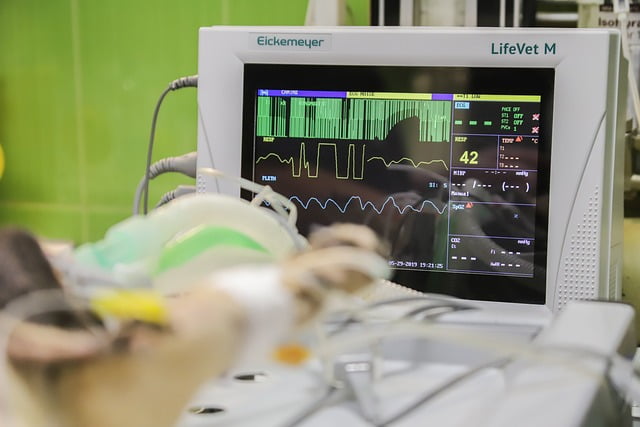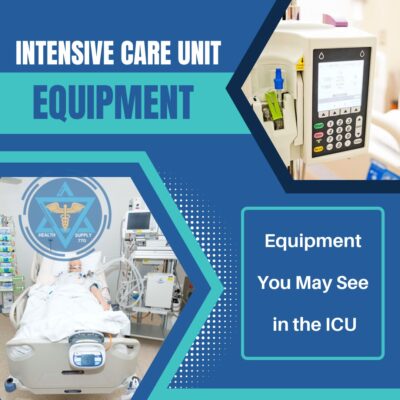ICU or Intensive Care Unit is a place where lives are saved. This unit provides immediate help to patients who are severely injured or have life-threatening problems. We all have seen movie scenes where they show someone on an ICU bed surrounded by doctors and nurses trying to save the patient’s life desperately and using different equipment. But what happens in the ICU? What equipment is used in this intensive care unit to save people’s lives?
When you peek into an ICU, you may see a lot of equipment that looks horrifying at first, but this ICU equipment can help save people’s lives. Today in this article, we are going to discuss different equipment used in the ICU. This list of equipment used in the ICU will help you gain a basic understanding of what makes the ICU a lifesaver. Let’s get started!
Breathing equipment
An ICU contains equipment that helps patients breathe when they are having difficulty in breathing. As breathing is a sign of life, it is highly significant that this breathing equipment should be a part of the ICU equipment list. Different equipment that helps to treat respiratory problems include
High-flow nasal cannula
High-flow nasal prongs help to deliver a high concentration of oxygen to the patients. A humidifier is used to provide oxygen which ensures that it is moist and does not dry the airways. It can be used as a therapy as well as when the patient has a break from a tighter mask.
Non-invasive ventilation (NIV)
The term non-invasive refers to “nothing going in”. This means that this equipment can help you breathe without inserting any tubes into your mouth. The non-invasive ventilation is given with the help of a mask that covers the patient’s nose and mouth. This mask is connected to a small machine that provides extra oxygen with every breath the patient takes. This extra oxygen supports the patient in breathing.
However, it should be ensured that the mask is secured tightly and there are no air leaks to ensure its proper functioning. This mask helps to increase blood oxygen levels and decrease carbon dioxide levels. It is often used to avoid the use of a ventilator and sometimes it is used for patients who have recently come off the ventilator. However, this non-invasive ventilation treatment can only be given to conscious patients as it requires the patients to breathe on their own.
Endotracheal tube (ET)
An ET is inserted into the patient’s windpipe through their mouth. It is often used for patients who cannot breathe properly because of lung problems. It is also used for patients who are not awake and cannot breathe on their own. This ET is connected to a ventilator.
The Ventilator
The ventilator is the ICU’s oxygen machine. The use of a ventilator depends upon the need of different patients. It can help patients in breathing if they are having difficulty breathing on their own or it can give them breaths. The ventilator has different settings that can be adjusted as per the requirements of the patient. The ventilator provides oxygen to the lungs with the help of a thin tube which also allows carbon dioxide to escape. This tube is placed through the mouth or nose in the windpipe.
Tracheostomy
A tracheostomy is a tube that goes directly into a patient’s windpipe. This tube is inserted into a patient’s windpipe by a surgeon by making a hole in the patient’s neck. The tracheostomy tube is attached to the ventilator or oxygen support. It is mostly used for patients who require long-term ventilation. It is also used to remove mucus or fluid from the lungs.
Equipment used for medicine, fluid, or nutrition
There is a lot of equipment in the ICU that helps provide medicines and nutrition to the patients when they cannot take these on their own. These pieces of equipment are highly beneficial for patients who are severely ill or injured and cannot do basic movements. This equipment includes:
Medicine pumps
These medicine pumps are used to deliver medicine to the patient. These pumps are used to deliver the right quantity of medicine at the proper time. This medicine is given with the help of an IV site or central line.
Gastrostomy (G-tube) or nasogastric (NG-tube) feeding tubes
Gastrostomy (G-tube) or nasogastric (NG-tube) feeding tubes are used to provide nutrients to patients who cannot eat by themselves. These nutrients are delivered to the patient either directly into the stomach or through the nose into the stomach. These are also used to give medicine. These are also helpful in removing excess fluids from the stomach.
Central venous catheter
A central venous catheter or a central line is a thin tube that is placed in an IV site. It is placed in a larger vein near the heart by threading it through a vein. It can stay in place longer than an IV. It can be used to deliver medicines, fluids, as well as nutrition quickly.
Intravenous site
An intravenous (IV) site helps to give access to the patient’s vein. It is mostly placed in the patient’s hand, foot, arm, or leg. One end of the tube is attached to the site while the other end is attached to the medicine pump. It helps deliver medicines and fluids quickly into the bloodstream. It is also helpful in taking blood samples.
Cardiac equipment
Different equipment is used in the ICU to monitor heart and blood pressure. This includes:
Cardiac monitor
This cardiac monitor is attached to the patient using wires and stickers. It is helpful for doctors and nurses as it constantly displays the patient’s details such as heart rate, breathing, and blood pressure.
Arterial line
An arterial line or art line is a catheter that is placed into an artery. It is usually a red line that goes into a patient’s arm and is connected to the cardiac monitor. It displays the blood pressure continuously. It is also helpful to take blood samples when required.
Cerebral equipment
There are several pieces of equipment in an ICU that help to treat brain-related problems which include
Ventriculostomy
It is a catheter that is used to control and watch the pressure in the brain which can rise due to the buildup of a natural fluid called cerebral spinal fluid. This catheter goes into the ventricles or spaces of the brain. Although it is a short-term treatment, it can help control the pressure in the brain.
Shunt
A shunt is a plastic tube that is placed underneath the skin into the fluid spaces of the brain. It helps to drain CSF from the brain down to the abdominal cavity. It is used in the treatment of Hydrocephalus. It is a condition in which the CSF builds up instead of absorbing. The buildup of this extra fluid can cause pressure on the brain which can lead to severe headaches and visual loss. If elevated CSF pressure is not treated, it can cause permanent visual loss or blindness. A shunt can help to drain this fluid and reduce brain pressure.
Other ICU equipment
Apart from this equipment, several other pieces of equipment are needed in an ICU for the treatment and recovery of patients. These are general-purpose devices that are used to know several factors including the patient’s blood pressure, temperature, amount of oxygen in the blood, and other problems. These equipment include:
Inflatable cuff
It is used to take blood pressure readings through the arm or leg. It collects and sends the data to a blood pressure monitor.
Temperature probes
Temperature probes are helpful in keeping track of a person’s body temperature.
Heart monitor
A heart monitor is used to track the heart rate of a patient. It includes a sensor that is attached to the patient’s chest which helps to keep track of the heart rate of the patient.

Heart monitor
Pulse oximeter
A pulse oximeter is a device that is clipped to the end of a finger. It is used to measure the amount of oxygen in the blood. It helps to determine how well oxygen is reaching the parts of your body that are farthest from your heart for example legs and feet.
Foley or Indwelling catheter
A Foley or Indwelling catheter is used in the ICU for patients who cannot go to the washroom on their own. It is used to drain urine.
Conclusion
Intensive care units are specialized units that hold a significant position in the treatment of several diseases. These are also extremely helpful in case of severe accident cases that require immediate treatment. ICUs are filled with special equipment that is used for several different purposes including respiratory problems, cardiac problems, brain injuries, and others. The equipment that is used in the ICUs is highly specialized devices that can help provide immediate treatment and relief to patients suffering from different health problems.

PhD Scholar (Pharmaceutics), MPhil (Pharmaceutics), Pharm D, B. Sc.
Uzma Zafar is a dedicated and highly motivated pharmaceutical professional currently pursuing her PhD in Pharmaceutics at the Punjab University College of Pharmacy, University of the Punjab. With a comprehensive academic and research background, Uzma has consistently excelled in her studies, securing first division throughout her educational journey.
Uzma’s passion for the pharmaceutical field is evident from her active engagement during her Doctor of Pharmacy (Pharm.D) program, where she not only mastered industrial techniques and clinical case studies but also delved into marketing strategies and management skills.
Throughout her career, Uzma has actively contributed to the pharmaceutical sciences, with specific research on suspension formulation and Hepatitis C risk factors and side effects. Additionally, Uzma has lent her expertise to review and fact-check articles for the Health Supply 770 blog, ensuring the accuracy and reliability of the information presented.
As she continues her PhD, expected to complete in 2025, Uzma is eager to contribute further to the field by combining her deep knowledge of pharmaceutics with real-world applications to meet global professional standards and challenges.








